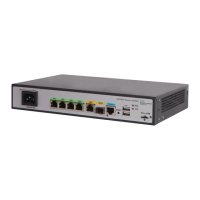92
display ntp-service trace
Use display ntp-service trace to display brief information about each NTP server from the local
device back to the primary time server.
Syntax
display ntp-service trace [ source interface-type interface-number ]
Views
Any view
Predefined user roles
network-admin
network-operator
Parameters
source interface-type interface-number: Specifies the source interface for sending NTP packets to
trace each NTP server from the local device back to the primary time server. The source IP address
of the NTP packets is the IPv4 address/IPv6 address of the specified source interface. If the IP
address of an NTP server is a link-local address, the link-local address of the outgoing interface of
NTP packets is used as the source IP address of the NTP packets. If you do not specify this option,
the interface that sends the tracing NTP packets acts as the source interface.
Usage guidelines
To trace back to the primary time server from the source interface, make sure the source interface
and the NTP servers from the local device to the primacy time server are reachable to each other.
Examples
#Display brief information about each NTP server from the local device back to the primary time
server.
<Sysname>display ntp-service trace
Server 127.0.0.1
Stratum 3, jitter 0.000, synch distance 0.0000.
Server 3000::32
Stratum 2 , jitter 790.00, synch distance 0.0000.
RefID 127.127.1.0
The output shows that server 127.0.0.1 is synchronized to server 3000::32, and server 3000::32 is
synchronized to the local clock.
Table 18 Command output
Server IP address of the NTP server.
Stratum Stratum level of the NTP server.
jitter
Root mean square (RMS) value of the clock offset relative to the upper-level
clock, in seconds.
synch distance
Synchronization distance relative to the upper-level
calculated from dispersion and roundtrip delay values.
RefID
Identifier of the primary time server. When the stratum level of the primary
reference clock is 0, it is displayed as
LOCL
. Otherwise, it is displayed as the IP
address of the primary time server.
